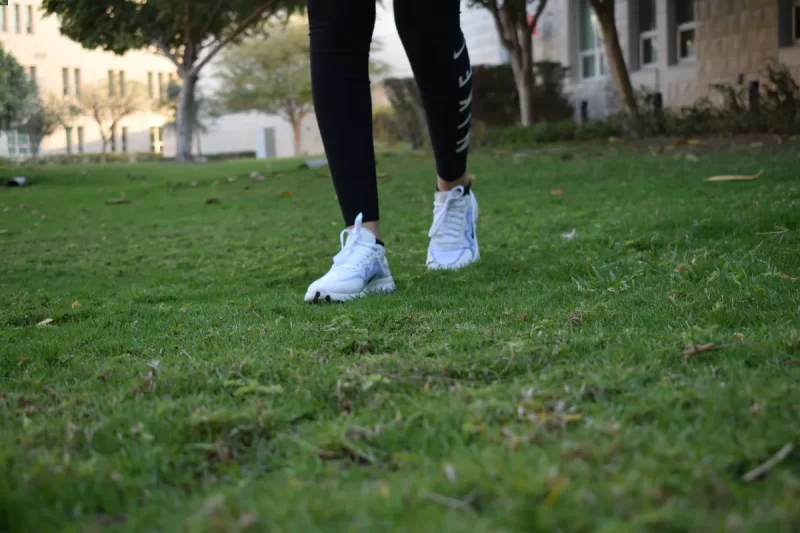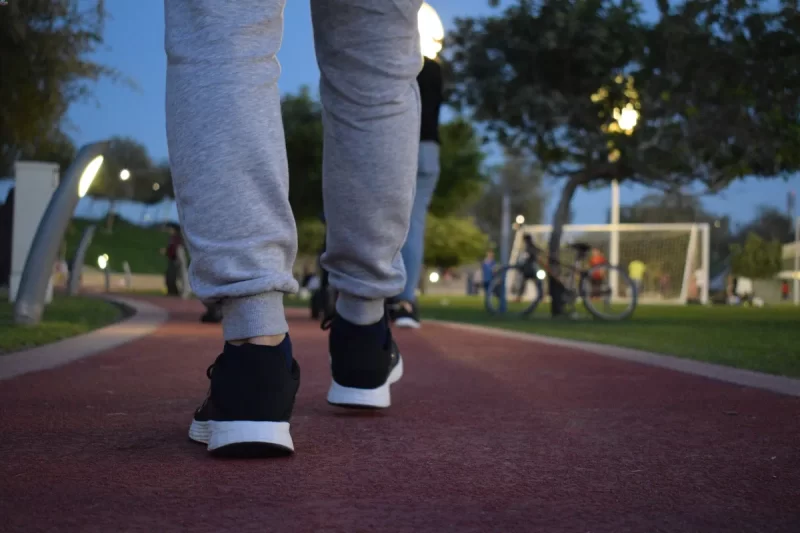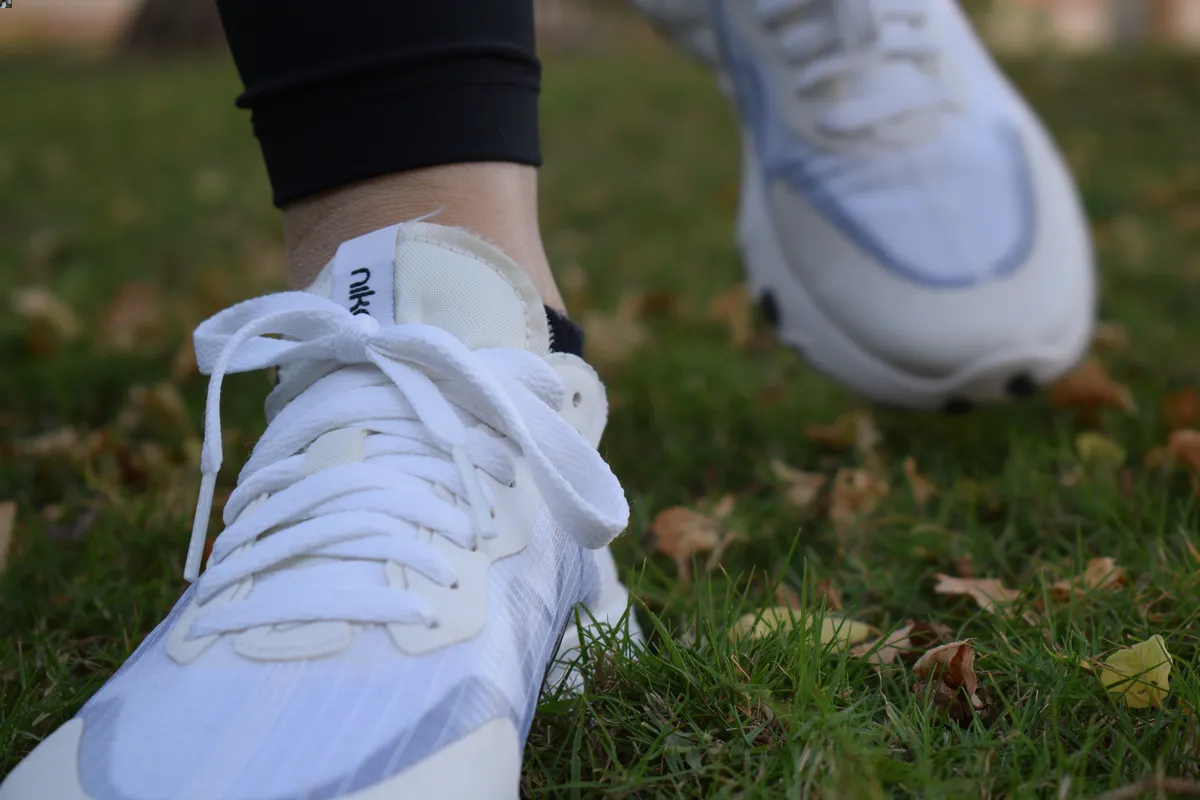It takes 9-10 minutes to walk 1000 steps at an average walking pace. The time mainly depends on your step length and walking speed.
Step length determines the distance you’ll walk in 1000 steps. For example, a step length of 80 cm (2′ 8″) means you’ll walk 0.8 km (0.5 miles), while a step length of 60 cm (2 ft.) means you’ll only walk 0.6 km (0.37 miles).
The following table can help you estimate the time to walk 1000 steps.
| Walking pace | Height | Time (min) |
|---|---|---|
| 1.5 mph (2.4 km/h) | 160 cm (5′ 3″) | 16.5 |
| Very slow | 170 cm (5′ 7″) | 17.5 |
| 180 cm (5′ 11″) | 18.6 | |
| 2.0 mph (3.2 km/h) | 160 cm (5′ 3″) | 12.4 |
| Slow | 170 cm (5′ 7″) | 13.2 |
| 180 cm (5′ 11″) | 13.9 | |
| 2.5 mph (4 km/h) | 160 cm (5′ 3″) | 9.9 |
| Moderate | 170 cm (5′ 7″) | 10.5 |
| 180 cm (5′ 11″) | 11.1 | |
| 3 mph (4.8 km/h) | 160 cm (5′ 3″) | 8.3 |
| Average | 170 cm (5′ 7″) | 8.8 |
| 180 cm (5′ 11″) | 9.3 | |
| 3.5 mph (5.6 km/h) | 160 cm (5′ 3″) | 7.1 |
| Brisk | 170 cm (5′ 7″) | 7.5 |
| 180 cm (5′ 11″) | 8 | |
| 4 mph (6.4 km/h) | 160 cm (5′ 3″) | 6.2 |
| Very brisk | 170 cm (5′ 7″) | 6.6 |
| 180 cm (5′ 11″) | 7 | |
| 4.5 mph (7.2 km/h) | 160 cm (5′ 3″) | 5.5 |
| Very very brisk | 170 cm (5′ 7″) | 5.8 |
| 180 cm (5′ 11″) | 6.2 | |
| 5.0 mph (8 km/h) | 160 cm (5′ 3″) | 5 |
| Jogging | 170 cm (5′ 7″) | 5.3 |
| 180 cm (5′ 11″) | 5.6 |
As the table shows, walking these 1000 steps might take anywhere from 5-18.6 minutes, depending on your pace and height. For an average speed of 3 mph (4.8 km/h), it might take 8-9 minutes.
How many steps to walk per day
You should walk 6500-12000 steps per day, depending on your age and goals. As you get older, fewer steps are required to indicate good health. For people older than 40, an increase of just 2200 steps per day decreases the risk for all-cause mortality by 48% (Source). For more details, please read my other article on the topic.
The following table shows the steps recommended based on your age and health (Source). Keep in mind that at least 3,000-6,000 steps should be at a brisk pace and that additional benefits are expected from adding vigorous-intensity activities.
| Age | Recommended daily steps |
|---|---|
| Preschool children (4-6 years) | 10,000-14,000 |
| Boys (6-11 years) | 13,000-15,000 |
| Girls (6-11 years) | 11,000-12,000 |
| Adolescents (12-19 years) | 10,000-12,000 |
| Adults (20-65 years) | 7,000-10,000 |
| Healthy older adults (65+ years) | 7,000-10,000 |
| Individuals living with a disability or chronic illness | 6,500-8,500 |

How to measure walking pace
The walking pace can be measured by dividing the distance walked by the time it took.
Walking Pace = Distance / Time
For example, if you walk a mile in 30 minutes, your pace is 1 mile / 0.5 hours = 2 mph. Similarly, walking 2 kilometers in 30 minutes means your pace is 2 km / 0.5 hours = 4 km/h.
The following table can help you calculate your pace based on a 20-minute walk. You can estimate the distance you walked using a map or your phone.
| Distance (miles) | Pace (mph) |
|---|---|
| 0.5 | 1.5 |
| 0.75 | 2.25 |
| 1 | 3 |
| 1.25 | 3.75 |
| 1.5 | 4.5 |
| 1.75 | 5.25 |
| 2 | 6 |
You can perform the same calculation for other distances and times.
How to measure step length
Step length is the distance between your feet as you walk, as shown in the picture below.

Your stride length is twice your step length. It is the distance measured between the same foot as you walk.
You can measure your step length by walking at a constant pace while counting the steps you take. Another way would be to estimate your step length from your height. Although not very accurate, the method estimates your step length reasonably.
You can also measure your step length directly using a measuring tape. Instead of making markings on the floor while you walk, try wetting your feet so that their print is clear on the ground.
After measuring your step length, you can easily estimate the distance you’ll walk for a set number of steps.
Distance = Step length × Number of steps.
You can use your phone to track the number of steps or a simple pedometer. I suggest something like the 3DFitBud (Amazon link). It’s simple and easy to use, has an extra-large display, and is accurate enough for all your tracking needs.
How many miles is 1000 steps
A thousand steps (1000 steps) is about 0.41-0.44 miles. The distance depends mainly on your step length, which is affected by your walking pace, height, and gender.

To estimate the distance you’ll cover by walking 1000 steps, go over the following table, which uses your height to calculate your step length.
| Height | Distance (miles) |
|---|---|
| 4′ 9″ (145 cm) | 0.37 |
| 4′ 10″ (147 cm) | 0.38 |
| 4′ 11″ (150 cm) | 0.39 |
| 5 ft. (152 cm) | 0.39 |
| 5′ 1″ (155 cm) | 0.4 |
| 5′ 2″ (157 cm) | 0.41 |
| 5′ 3″ (160 cm) | 0.41 |
| 5′ 4″ (163 cm) | 0.42 |
| 5′ 5″ (165 cm) | 0.43 |
| 5′ 6″ (168 cm) | 0.43 |
| 5′ 7″ (170 cm) | 0.44 |
| 5′ 8″ (173 cm) | 0.45 |
| 5′ 9″ (175 cm) | 0.45 |
| 5′ 10″ (178 cm) | 0.46 |
| 5′ 11″ (180 cm) | 0.47 |
| 6 ft. (183 cm) | 0.47 |
| 6′ 1″ (185 cm) | 0.48 |
| 6′ 2″ (188 cm) | 0.48 |
| 6′ 3″ (191 cm) | 0.49 |
As you can see from the table, the total distance walked can differ by up to 0.12 miles or 634 feet. It doesn’t sound like a lot, but distances add up quickly. This is especially true if you’re aiming to walk 10,000 steps a day, which translates to a difference of a whole mile.
To estimate the distance walked in 10,000 steps, you can read my other article, which goes into more detail.
Is walking a sustianable activity?
Walking is a more sustainable option than other transportation methods since there are no associated emissions. Does this mean you should start walking to work or school? It depends. There are a lot of factors that can affect your decision.
You should consider public transportation options if you live far from your office. Buses and trains significantly reduce your carbon footprint because you get to share them with others. Less traffic also means less time spent inside polluting vehicles for everyone else. Another emission-free option is cycling. Check out my other article to read about the benefits of cycling.
Another thing to consider is how much free time you have. A brisk walk may be out of the question if you’re too busy. You also have to account for the time it takes you to freshen up or shower after you’re done.
Finally, it would be best to consider environmental effects other than emissions. Water, for example, is a vital resource, especially in places facing water scarcity. Using water for showers twice a day is not exactly environmentally friendly. You must consider all the different aspects and evaluate the best option for your situation by comparing its related effects.

